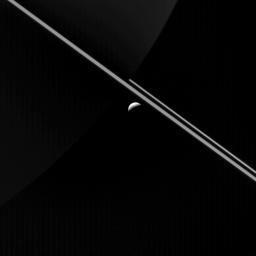
|
Dark and Arc
- Click the image above for a larger view
- Full-Res JPEG (1020 x 1020) (49.2 kB)
- Full-Res TIFF (1020 x 1020) (419.9 kB)
Caption:
At first glance, the most obvious features in this image from NASA's Cassini spacecraft are Saturn's rings and the icy moon Enceladus. Upon closer inspection, Saturn's night side is also visible (near top center), faintly illuminated by sunlight reflected off the rings.
In this view, icy Enceladus (313 miles or 504 kilometers across) hangs in the space between Cassini and the giant planet.
This view looks toward the sunlit side of the rings from 0.14 degrees above the ring plane. The image was taken in visible light with the Cassini spacecraft wide-angle camera on Aug. 18, 2015.
The view was acquired at a distance of approximately 87,000 miles (139,000 kilometers) from Enceladus. Image scale is 5 miles (8 kilometers) per pixel.
Background Info:
The Cassini mission is a cooperative project of NASA, ESA (the European Space Agency) and the Italian Space Agency. The Jet Propulsion Laboratory, a division of the California Institute of Technology in Pasadena, manages the mission for NASA's Science Mission Directorate, Washington. The Cassini orbiter and its two onboard cameras were designed, developed and assembled at JPL. The imaging operations center is based at the Space Science Institute in Boulder, Colorado.
For more information about the Cassini-Huygens mission visit http://saturn.jpl.nasa.gov and http://www.nasa.gov/cassini . The Cassini imaging team homepage is at http://ciclops.org .
Cataloging Keywords:
| Name | Value | Additional Values |
|---|---|---|
| Target | Enceladus | Saturn Rings |
| System | Saturn | |
| Target Type | Satellite | Ring |
| Mission | Cassini-Huygens | |
| Instrument Host | Cassini Orbiter | |
| Host Type | Orbiter | |
| Instrument | Imaging Science Subsystem (ISS) | |
| Detector | Wide Angle Camera | |
| Extra Keywords | Grayscale, Visual | |
| Acquisition Date | ||
| Release Date | 2016-06-27 | |
| Date in Caption | 2015-08-18 | |
| Image Credit | NASA/JPL-Caltech/Space Science Institute | |
| Source | photojournal.jpl.nasa.gov/catalog/PIA20487 | |
| Identifier | PIA20487 | |
